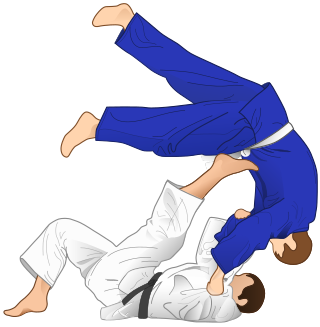
Nage-no-kata is one of the two randori-no-kata of Kodokan Judo. It is intended as an illustration of the various concepts of nage-waza that exist in judo, and is used both as a training method and as a demonstration of understanding.
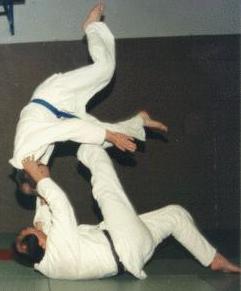
In martial arts, a throw is a grappling technique that involves off-balancing or lifting an opponent, and throwing them to the ground, in Japanese martial arts referred to as nage-waza, 投げ技, "throwing technique". Throws are a subset of takedown (grappling). Certain throwing techniques called sacrifice throws involve putting oneself in a potentially disadvantageous position, such as on the ground, in order to execute a throw.
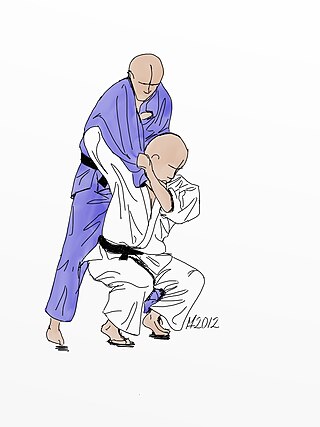
Seoi nage is a throw in judo. It is one of the traditional forty throws of judo as developed by Jigoro Kano. It belongs to the first group, Dai Ikkyo, of the traditional throwing list, Gokyo, of Kodokan Judo. It is also part of the current official throws of Kodokan Judo. It is classified as a hand technique, te-waza, and is the second throw performed in the Nage-no-kata. Seoi nage literally means "over the back throw", but has also been translated as a "shoulder throw", as the opponent or uke is thrown over the thrower or tori's shoulder.

Uki Goshi (浮腰) is one of the original 40 throws of Judo as developed by Jigoro Kano. It belongs to the first group, Dai Ikkyo, of the traditional throwing list, Gokyo, of Kodokan Judo. It is also part of the current 67 Throws of Kodokan Judo. It is classified as a hip technique, Koshi-Waza. Uki goshi is known as a favorite throw of Jigoro Kano himself. It is demonstrated in the Nage no Kata. It used to be much drilled in traditional judo dojos.
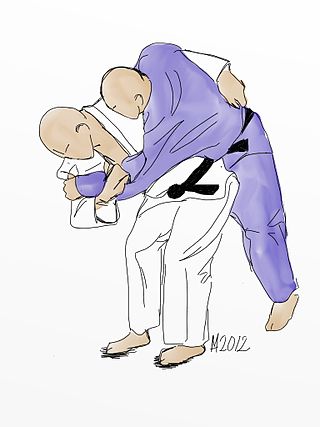
Ō goshi is one of the original 40 throws of judo as compiled by Jigoro Kano. It belongs to the Dai ikkyo of the Gokyo-no-waza, of Kodokan Judo. It is also part of the current 67 throws of Kodokan Judo. It is classified as a koshi-waza.

Osotogari (大外刈) is one of the original 40 throws of Judo as developed by Jigoro Kano. It belongs to the first group, Dai Ikkyo, of the traditional throwing list, Gokyo, of Kodokan Judo. It is also included in the current 67 Throws of Kodokan Judo. It is classified as a foot technique, Ashi-Waza.

Ōuchi gari (大内刈) is one of the original 40 throws of Judo as developed by Kanō Jigorō. It belongs to the first group, Dai Ikkyo, of the traditional throwing list, Gokyo, of Kodokan Judo. It is also included in the current 67 Throws of Kodokan Judo. It is classified as a foot technique, Ashi-Waza.

The ippon seoi nage is a throw in judo. It is a variant of Seoi nage, and is one of the nineteen accepted techniques in Shinmeisho No Waza of Kodokan Judo. It is classified as a hand throwing technique, or te-waza. Ippon seoi nage literally means "one arm over the back throw", but has also been translated as a "one arm shoulder throw", as the opponent or uke is thrown over the thrower or tori's shoulder.

Tomoe nage (巴投) is one of the traditional forty throws of jujutsu and Judo. It belongs to the third group (Sankyo) of the traditional throwing list, the traditional Gokyo, and the current 67 Throws of Kodokan Judo.

Uki otoshi (浮落), or "floating drop," is one of the traditional forty throws of Judo as developed by Jigoro Kano. It belongs to the fourth group, Dai Yonkyo, of the traditional throwing list, Gokyo-no-Nagewaza, of Kodokan Judo. It is also part of the current 67 Throws of Kodokan Judo. The technique is categorized as a hand technique, Te-waza.

Tai Otoshi (体落), is one of the original 40 throws of Judo as developed by Jigoro Kano.

Yoko gake (横掛) is one of the original forty throws of judo as developed by Jigoro Kano. It belongs to the fifth group, Gokyo, of the traditional throwing list, Gokyo, of Kodokan Judo. It is also part of the current 67 throws of Kodokan Judo. It is classified as a side sacrifice technique, Yoko-sutemi. Considered one of the techniques most dangerous for the Uke, its use in competition is infrequent; contributing to the risk is that Uke does not have sufficient space to dissipate the impact of the fall adequately. Another contributing factor is the necessity for Uke to compensate in order to achieve proper rotation in executing the breakfall; if the Uke does not succeed in meeting these criteria, the force of the impact can be severe, even to the point of possible spinal injury. For these reasons, the technique is generally reserved for expert judoka.

Kosoto Gake (小外掛), sometimes known as "minor outer hook", the English translation, is one of the original 40 throws of Judo as developed by Jigoro Kano. It belongs to the third group, Sankyo, of the traditional throwing list, Gokyo, of Kodokan Judo. It is also part of the current 67 Throws of Kodokan Judo. It is classified as a foot technique, Ashi-waza. It is often used as a counter-throw to tai-otoshi, after having stepped over the leg. To perform the technique, the tori grabs uke using one of several compatible grips - the traditional example being the sleeve collar grip. He then steps forwards diagonally to place all of uke's weight on the foot tori wishes to reap. This leg is reaped by wrapping the leg around his leg from the outside and plucking the ankle or calf upward with the back of tori's own ankle or calf respectively. Because the weight was planted on this foot due to off-balancing uke, tori can make him fall. If uke's weight is not on the leg being swept, uke will remain stable and be able to keep his balance. This should all be done in a fluid motion so that uke's weight is moving backwards whilst the leg is being reaped, otherwise it will be too heavy to lift although the throw can still work sometimes from this position.

Yoko Guruma (横車) is one of the original 40 throws of judo as developed by Jigoro Kano. It belongs to the fifth group, Gokyo, of the traditional throwing list, Gokyo, of Kodokan Judo. It is also part of the current 67 throws of Kodokan Judo. It is classified as a side sacrifice technique, Yoko-sutemi. This technique is considerably difficult to perform, and can be used as either a direct attack or a counter. In classical study of nage-waza, it is preferable to use it as a counter throw to seoi-nage.

Ura Nage (裏投) is one of the original 40 throws of Judo as developed by Jigoro Kano. It belongs to the fifth group, Gokyo, of the traditional throwing list, Gokyo, of Kodokan Judo. It is also part of the current 67 Throws of Kodokan Judo. It is classified as a rear sacrifice technique, Ma-sutemi.

Osoto Otoshi (大外落) is one of the preserved throwing techniques, Habukareta Waza, of Judo. It belonged to the fourth group, Yonkyo, of the 1895 Gokyo no Waza lists. It is categorized as a foot technique, Ashi-waza.
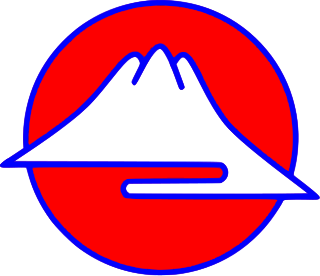
Yoseikan Aikido is the aikido taught at the Yoseikan Dojo in Shizuoka, Japan, under the direction of Minoru Mochizuki.
The Nage-waza ura-no-kata is a judo kata that focuses on counter-attacks to throwing techniques. Its superiority, over Gonosen-no-kata, can be attributed to the fact that it was developed by the sublimely talented Mifune Kyūzō, to be a formal kata, and not some ad hoc collection of counters proceeded by some protocol. The exercise is not an officially recognized Kodokan kata.
















